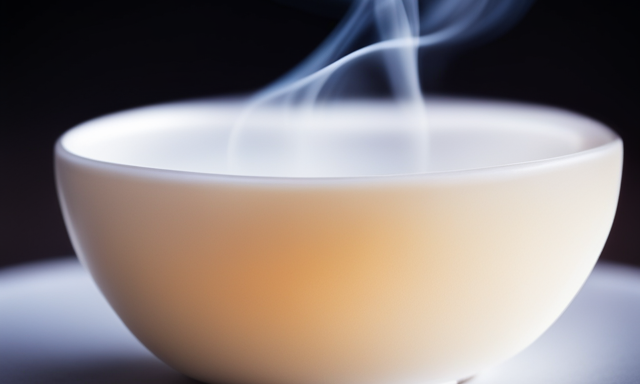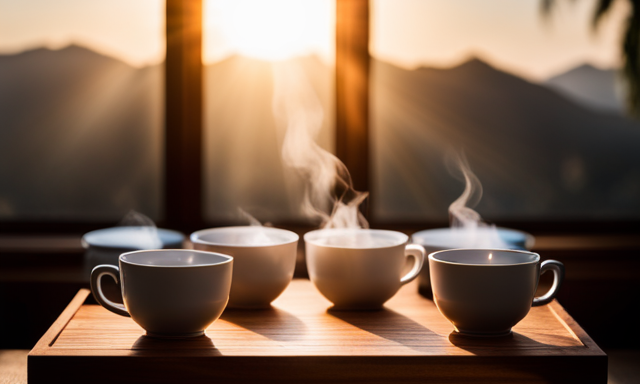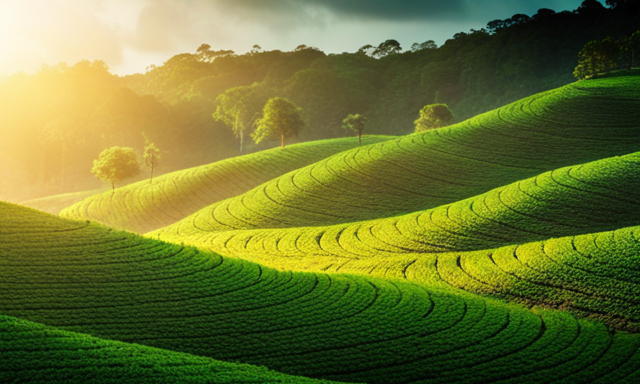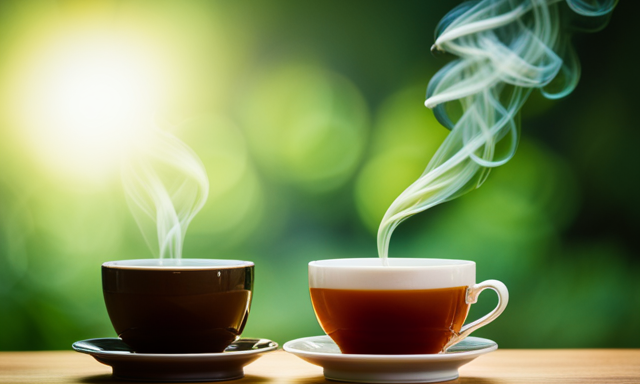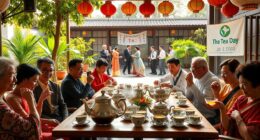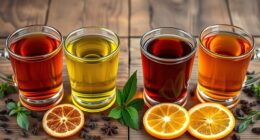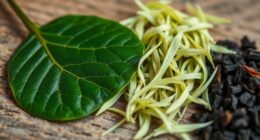They say that patience is a virtue, and when it comes to steeping oolong tea, I couldn’t agree more. As a tea enthusiast, I’ve come to appreciate the art of brewing this delicate beverage to perfection. Oolong tea, with its nuanced flavors and aromas, requires a careful balance of time and technique to unlock its true potential.
In this article, I will guide you through the process of steeping oolong tea, from understanding the different types and selecting the right water temperature to preparing the leaves and mastering the art of steeping time.
Whether you prefer a light or dark oolong, I will provide you with the techniques to enhance the flavor and avoid oversteeping.
So, grab your favorite tea infuser or teapot, and join me on this journey to discover the secrets of steeping oolong tea. Get ready to savor the perfect cup, one sip at a time.
Key Takeaways
- Steeping time for oolong tea varies depending on the type of oolong
- Proper steeping time allows for the flavors and aromas of oolong to unfold
- The craftsmanship of steeping oolong leaves contributes to a rich and complex cup of tea
- Take the time to savor and appreciate the nuances and complexities of oolong tea while enjoying each sip.
Understanding the Different Types of Oolong Tea
Understanding the different types of oolong tea is essential for any tea enthusiast. Oolong tea can vary greatly in flavor and aroma, depending on factors such as oxidation level and processing methods. Some common types of oolong tea include Tie Guan Yin, Da Hong Pao, and Oriental Beauty. Tie Guan Yin is known for its floral and creamy taste, while Da Hong Pao has a rich and roasted flavor. Oriental Beauty, on the other hand, is known for its sweet and fruity notes. Each type of oolong tea offers a unique experience, so it’s worth exploring different varieties to find your favorite.
Choosing the Right Water Temperature
To ensure optimal flavor extraction, it’s crucial to choose the right water temperature when brewing your oolong tea. Here are some key factors to consider when selecting the water temperature for your oolong tea:
-
Different oolong teas require different water temperatures. For lightly oxidized oolongs, such as green oolong, a lower water temperature around 170°F to 190°F is ideal. For darker oolongs, like roasted oolong, a slightly higher temperature ranging from 190°F to 205°F works best.
-
Water quality is equally important. Using filtered or spring water ensures that there are no impurities that can affect the taste of your tea. Avoid using tap water as it may contain chlorine or other chemicals.
-
Steeping your oolong tea at the right temperature allows the leaves to unfurl and release their complex flavors and aromas.
When you’ve chosen the perfect water temperature for your oolong tea, it’s time to move on to preparing your tea leaves.
Preparing Your Tea Leaves
Once you’ve selected the perfect water temperature, it’s time to get your tea leaves ready.
Choosing the right tea leaves is crucial for a delicious cup of oolong tea. Opting for loose leaf tea offers numerous benefits. Loose leaf tea provides a higher quality and fresher taste compared to tea bags. The leaves are whole, allowing them to expand and release their full flavor during steeping.
To prepare your tea leaves, start by measuring the appropriate amount for your desired strength. Generally, a teaspoon of tea leaves per cup is a good guideline. Place the leaves in a tea infuser or teapot, ensuring they have enough room to expand.
Gently pour the hot water over the leaves, allowing them to steep for the recommended time. This will be discussed in the subsequent section about the importance of steeping time.
The Importance of Steeping Time
Make sure not to rush the steeping process. The importance of allowing your tea leaves to steep for the recommended time cannot be overstated if you want to fully savor the flavors of your cup of oolong.
The effects of steeping time on oolong tea flavor are significant. Steeping for too short a time can result in a weak and insipid brew, while steeping for too long can lead to a bitter and overpowering taste.
To ensure the perfect cup of oolong, it’s crucial to know the optimal steeping time for different types of oolong tea. Lighter oolongs, such as green oolong, typically require a shorter steeping time of around 1-2 minutes, while darker oolongs, like roasted oolong, benefit from a longer steeping time of 3-5 minutes.
Understanding these nuances will allow you to unlock the true potential of your oolong tea.
Transitioning into the next section, it’s important to explore the different steeping techniques for light and dark oolongs.
Light vs. Dark Oolong: Different Steeping Techniques
When exploring the nuances of steeping lighter and darker oolongs, it’s essential to employ distinct techniques that enhance the delicate flavors and robust profiles of each variety.
Light oolongs, such as Tie Guan Yin, require a shorter steeping time of around 1-2 minutes to preserve their floral and fruity notes.
On the other hand, darker oolongs like Da Hong Pao necessitate a longer steeping time of 3-4 minutes to bring out their rich and toasty flavors.
It’s important to note that both types of oolongs offer different flavor profiles and health benefits. Light oolongs are known for their calming and soothing properties, while dark oolongs are believed to aid digestion and promote weight loss.
Now, let’s delve into the next section about experimenting with steeping times to further unlock the full potential of oolong tea’s diverse flavors.
Experimenting with Steeping Times
Discover the art of perfecting the steeping process by exploring different durations, allowing the flavors of your oolong tea to unfold like a delicate dance on your taste buds.
When experimenting with tea bags, try steeping oolong for 3 minutes to achieve a light and refreshing brew, or increase the steeping time to 5 minutes for a stronger and more robust flavor.
For a unique twist, you can even steep oolong in cold water overnight to create a smooth and subtly sweet iced tea. This method extracts the tea’s delicate flavors without the bitterness that can sometimes result from hot water steeping.
Once you’ve mastered these techniques, you can move on to using a tea infuser or teapot to further enhance your oolong tea experience, unlocking even more complex flavors and aromas.
Using a Tea Infuser or Teapot
Enhance your oolong tea experience to a whole new level by effortlessly infusing the rich and complex flavors using a tea infuser or teapot. These tea brewing techniques allow for a more controlled and precise steeping process, ensuring that you extract the optimal flavors from your oolong tea leaves.
When using a tea infuser or teapot, it’s important to consider the size and shape of your tea leaves. For larger leaves, a teapot with a built-in strainer may be more suitable, while a finer mesh infuser works well for smaller leaves.
Additionally, be mindful of the water temperature and steeping time, as these factors greatly influence the taste of your oolong tea. By following these steeping tips, you can savor the nuanced aromas and flavors of oolong tea.
To avoid oversteeping, let’s explore some techniques to find the perfect balance.
Avoiding Oversteeping
To truly indulge in the rich and nuanced flavors of oolong tea, it’s crucial to master the art of avoiding oversteeping. Here are three essential tips to help you avoid bitterness and find the optimal steeping time:
-
Experiment with different steeping times: Start with the recommended steeping time and gradually adjust to your preference. This will allow you to discover the perfect balance between flavor and strength.
-
Use water at the right temperature: Oolong tea requires water that is neither too hot nor too cold. Aim for a temperature between 180°F and 200°F (82°C to 93°C) to avoid extracting unwanted bitterness.
-
Monitor the color and aroma: Keep a close eye on the color of the tea as it brews. When it reaches a golden or amber hue, it’s usually a good indication that it’s ready. Additionally, inhale the aroma to gauge the strength and complexity of the brew.
By mastering these techniques, you’ll be able to enjoy a perfectly steeped cup of oolong tea, enhancing the flavor with multiple infusions.
Enhancing the Flavor with Multiple Infusions
Immerse yourself in an exquisite tea experience by unlocking the full potential of oolong through the art of multiple infusions.
One of the unique qualities of oolong tea is its ability to be steeped multiple times, allowing you to savor the evolving flavors with each infusion. This technique not only enhances the flavor but also showcases the complexity and depth of oolong.
With each subsequent steeping, different layers of the tea leaves are extracted, resulting in a nuanced and rich cup of tea. By adjusting the steeping time and water temperature between infusions, you can tailor the flavor extraction to your preference, whether you enjoy a lighter, floral cup or a more robust, full-bodied brew.
So, as you explore the world of oolong, take delight in the multiple infusions that await you, and prepare to discover the true essence of this remarkable tea.
Now, let’s move on to enjoying the perfect cup of oolong tea.
Enjoying the Perfect Cup of Oolong Tea
After enhancing the flavor with multiple infusions, it’s time to sit back and enjoy the perfect cup of oolong tea.
Infusing oolong tea is an art that requires precision and attention to detail. The first step is to choose high-quality oolong leaves and measure the right amount for your cup.
Next, heat fresh water to the recommended temperature for the specific oolong tea you’re using. Gently place the leaves in a teapot or mug and pour the hot water over them.
Allow the leaves to steep for the appropriate amount of time, which can vary depending on the type of oolong tea. As the leaves steep, their flavors and aromas will unfold, creating a rich and complex cup of tea.
Finally, pour the tea into your favorite cup and savor every sip, appreciating the craftsmanship that went into steeping those oolong leaves.
Frequently Asked Questions
Can I steep oolong tea for longer than the recommended time?
Oversteeping oolong tea can lead to a bitter taste, but can also intensify its unique flavors. Different steeping times can indeed result in varying levels of caffeine, offering a range of experiences.
Is it necessary to use a tea infuser or teapot when steeping oolong tea?
When steeping oolong tea, it is not necessary to use a tea infuser or teapot. Both loose leaf and tea bags can be used. However, using a teapot or infuser allows for better control of the brewing process and enhances the flavor.
Can I reuse oolong tea leaves for multiple infusions?
Yes, you can reuse oolong tea leaves for multiple infusions. By using different steeping techniques such as adjusting water temperature and steeping time, you can extract different flavors from the leaves each time.
How do I know if I have oversteeped my oolong tea?
If you have oversteeped your oolong tea, signs may include a bitter taste and a dark color. To avoid this, adjust the steeping time based on the variety of oolong tea you are using.
Can I use boiling water to steep oolong tea?
Yes, using boiling water to steep oolong tea is recommended as it brings out the full flavor. However, be cautious not to steep it for an extended period of time as it may result in a bitter taste.
Conclusion
In conclusion, steeping oolong tea is a delicate process that requires attention to detail and a little bit of experimentation. By understanding the different types of oolong tea and choosing the right water temperature, you can enhance the flavor and aroma of your brew.
Remember to prepare your tea leaves properly and be mindful of the steeping time to avoid oversteeping. Whether you prefer a light or dark oolong, using a tea infuser or teapot can help achieve the perfect cup.
Don’t forget, multiple infusions can enhance the flavor, so enjoy the journey of discovering your ideal oolong tea. Cheers!


